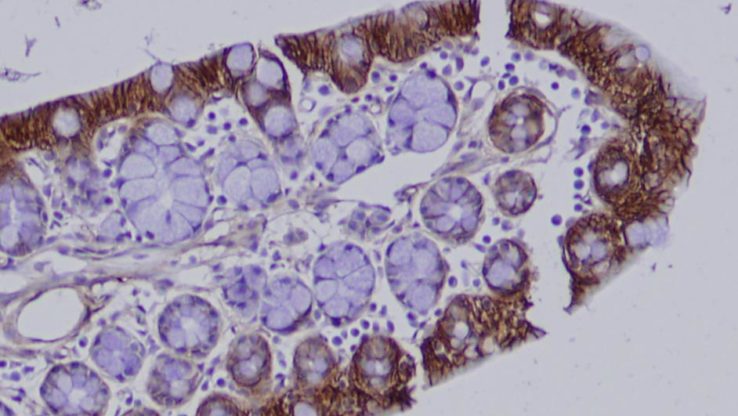
Mapping the early effects of the Huntington’s disease mutation in mice
A multi-institute collaboration sought to map in high-resolution the earliest effects of the Huntington’s disease mutation in mice.

Genomic Architecture of Inflammatory Bowel Disease in 5 Families with Multiple Affected Individuals
In medical genetics it is an unsolved question to what degree complex diseases (such as inflammatory bowel disease) are influenced by rare variants with potentially large effects in relation to the many common and weak-effect variants that have been identified in genome-wide association studies (GWAS).
By analyzing whole-genome sequences of five families with a high burden of inflammatory bowel disease (IBD) we aimed to elucidate the genomic architecture of IBD.
We identified rare candidate variants and followed up one of them, a novel missense variant in TRIM11. We found evidence that the variant may foster IBD development by increasing inflammatory signaling in the gut.

Researchers determine architecture of a macromolecular complex regulating gene expression and DNA repair
The expression, or transcription, of genes controls the identity and function of a cell. DNA damage caused by UV light or other carcinogens must be repaired to maintain genome integrity. The general transcription factor TFIIH plays central roles in both processes and is also important to couple gene transcription with DNA repair. Researchers at the Institute for Systems Biology, in collaboration with the University of California, San Francisco, the University of Colorado Boulder, and the Fred Hutchinson Cancer Research Center, have mapped the architecture of the multi-subunit TFIIH complex. This research, published online in Molecular Cell on Sept. 4, 2015, represents a breakthrough in understanding the structural basis for transcription and DNA repair, and provides critical insights into how disruption of the TFIIH complex can lead to cancer and other diseases.

Understanding the Genetic ‘Architecture’ of Bipolar Disorder
Bipolar disorder (BD) is a common, severe and recurrent psychiatric disorder with no known cure and substantial morbidity and mortality. Heritable causes contribute up to 80 percent of lifetime risk for BD.
Scientists hope that identifying the specific genes involved in risk for bipolar disorder will lead to new ways to treat the disease.
ISB researchers identified contributions of rare variants to BD by sequencing the genomes of 200 individuals from 41 families with BD.

Pushing the Molecular Switches of Tuberculosis Into Overdrive
Mycobacterium tuberculosis (MTB) infects more than 1.5 billion people worldwide partly due to its ability to sense and adapt to the broad range of hostile environments that exist within hosts.
To study how MTB controls its responses at a molecular level, ISB researchers and their collaborators at Seattle Biomed perturbed almost all MTB transcription factor regulators and identified the affected genes.
This comprehensive map of molecular switches in MTB provides a basis for understanding control mechanisms and can inform future efforts to rewire MTB responses for more favorable disease outcomes.

Uncovering the Genetic Adaptability of Tuberculosis
The Institute for Systems Biology and Seattle BioMed have collaborated to reconstruct the gene regulatory network of the human pathogen Mycobacterium tuberculosis.
Finely tuned gene regulation has allowed Mycobacterium tuberculosis to survive unnoticed in an apparently healthy host for decades; understanding those subtleties is critical for advancing treatment.
The identification of co-regulated sets of genes and their regulatory influences offers validated predictions that will help guide future research into Mycobacterium tuberculosis pathogenicity.

Tiniest Malfunctions in a Cell Can Cause Devastating Diseases
ISB researchers are studying peroxisomes, which are cellular organelles that are linked to a rare syndrome that causes progressive organ complications and infant mortality.
Peroxisomes have a role in metabolizing and breaking down cellular waste.
Because peroxisomes easily change shape and function according to a cell’s needs, a systems approach is necessary to help decipher that complexity.

Matters of the Head and the Heart
Previous links between posttraumatic stress disorder (PTSD) and cardiovascular disorders were mostly thought to be psychological.
Using mouse models, researchers at ISB and U.S. Army Center for Environmental Health Research found physical injury of heart tissue as a result of exposure to stressful environments.
This research is important for developing future methods for early and objective diagnosis, and new therapeutic approaches for patients with PTSD and PTSD-associated ailments.

Adaptor MAVS Promotes NLRP3 Mitochondrial Localization and Inflammasome Activation
NLRP3 is a key component of the macromolecular signaling complex called the inflammasome that promotes caspase 1-dependent production of IL-1β. The adaptor ASC is necessary for NLRP3-dependent inflammasome function, but it is not known whether ASC is a sufficient partner and whether inflammasome formation occurs in the cytosol or in association with mitochondria is controversial. Here, we show that the mitochondria-associated adaptor molecule, MAVS, is required for optimal NLRP3 inflammasome activity.



